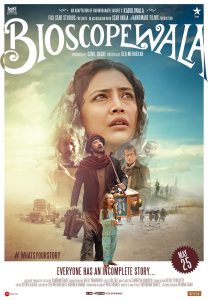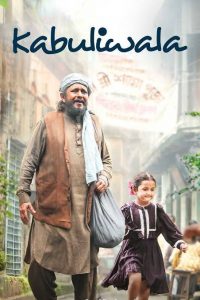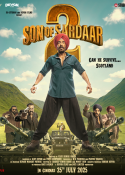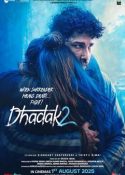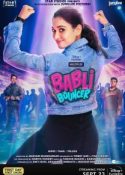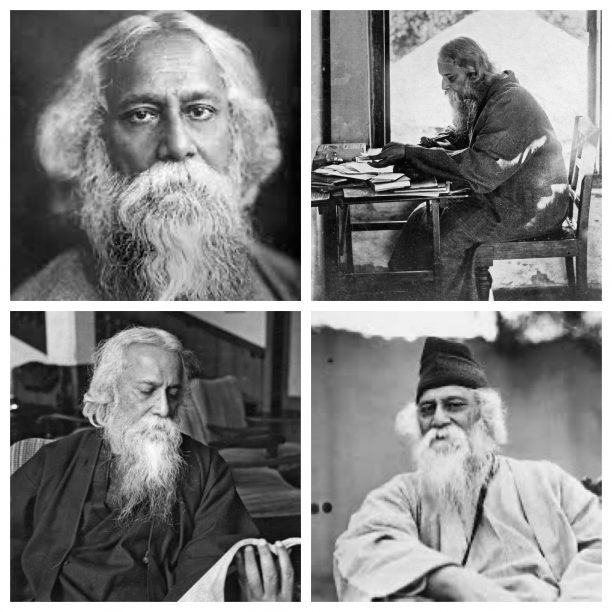 Filmmakers in Bengal love Tagore: not just Sharmila but also the Grand Old Man of letters Rabindranath Tagore whose novels and short stories have been ternally adapted by Bengali filmmakers from Satyajit Ray (Teen Kanya, Charulata, Ghaire Bhaire) to Rituparno Ghosh (Chokher Bali). In Hindi too, Tagore was dominant force until the close of the last century. Here are the 10 notable films in Hindi that were based on Tagore’s fiction.
Filmmakers in Bengal love Tagore: not just Sharmila but also the Grand Old Man of letters Rabindranath Tagore whose novels and short stories have been ternally adapted by Bengali filmmakers from Satyajit Ray (Teen Kanya, Charulata, Ghaire Bhaire) to Rituparno Ghosh (Chokher Bali). In Hindi too, Tagore was dominant force until the close of the last century. Here are the 10 notable films in Hindi that were based on Tagore’s fiction.
1. Ghunghat (1960):
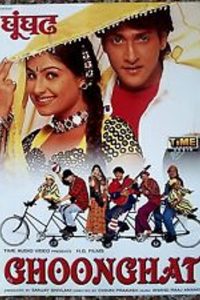
Based on Tagore’s celebrated novel Nouka Dubi this is the story of marital misalliances told against the backdrop of a ferocious storm and a boat capsize. Though a bit too melodramatic and cluttered with convenient coincidences, the story has a powerful message on giving women the right to decide which way their heart goes. Ghunghat had a stellar performance by Bina Rai. In a Anthony Hopkins-Chadwick Boseman situation, Ms Rai took the Filmfare award from Madhubala for a far more popular performance in Mughal-e-Azam. Ghunghat is also notable for Ravi ’s music score with Lataji’s ‘Lage na mora jiya’ topping charts for months. The same Tagore story was filmed as Milan in 1946 by Nitin Bose and by Rituparno Ghosh in Bengali as Nouka Dubi featuring sisters Raima and Riya Sen.
2. Kabuliwala (1961):
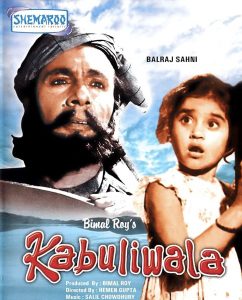
Bengali director Hemen Gupta adapted Tagore’s 1892 short story into an immensely moving story of a bond that grows between a Pathan dryfruit seller from Afghanistan and a little girl Mini in Kolkata where the Pathan sells his merchandise. A tender tale told in wispy whispering colours of love and friendship Kabuliwala remains a stirring testament to its times as well as a timeless tale of togetherness. Most memorable for Balraj Sahni’s towering performance in the title role and that Manna Dey ode to homesickness ‘Ae mere pyare watan’. Recently Danny Denzongpa, reprised the role in Bioscopewala (the Pathan changeth his profession) and made it clear he wasn’t competing with the great Balraj Sahni. Copy that.
3. Uphaar (1971):
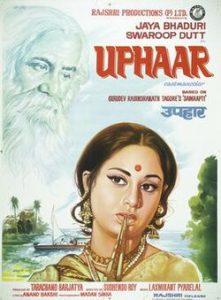
Jaya Bhaduri as the child bride Mrinmayee gave her career’s best performance. Even Tagore, who wrote the story Samapti in 1893, would have been pleased with Ms Bhaduri’s ebullient performance as the precocious child-woman whose patient husband (Swarup Dutt) teaches her a thing or two about meaningful relationships. Though Guddi got her more attention at career-start I think Jaya was far more spirited here. Aparna Sen had played the same child-woman in Satyajit Ray’s Teen Kanya.
4. Geet Gaata Chal (1975):
 Rajshri’s Productions who did Uphaar, this time took on Tagore’s novel, Atithee, which stands out for focusing on a male protagonist. Normally Tagore’s heroes were women. This time it’s Shyam, played by Sachin Pilgaonkar in his first adult role. Ravindra Jain’s music went a long way in making this small-budget musical a hit.
Rajshri’s Productions who did Uphaar, this time took on Tagore’s novel, Atithee, which stands out for focusing on a male protagonist. Normally Tagore’s heroes were women. This time it’s Shyam, played by Sachin Pilgaonkar in his first adult role. Ravindra Jain’s music went a long way in making this small-budget musical a hit.
5. Lekin (1990):
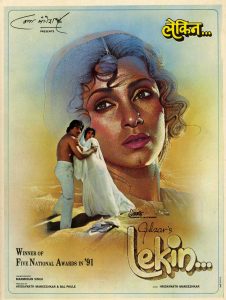 The last significant Tagore adaptation in Hindi and director Gulzar’s first tryst with Tagore, this ghost story was adapted from Tagore’s short story Kshudhita Pashaan. Dimple Kapadia who played the ghost Rewa didn’t stop calling producer Lata Mangeshkar and director Gulzar until she got the role. She also got to sing Lataji and composer Hridaynath Mangeshkar’s exquisite melodies ‘Yaara seeli seeli’, ‘Suniyoji araj’ and ‘Kesariya balma’.
The last significant Tagore adaptation in Hindi and director Gulzar’s first tryst with Tagore, this ghost story was adapted from Tagore’s short story Kshudhita Pashaan. Dimple Kapadia who played the ghost Rewa didn’t stop calling producer Lata Mangeshkar and director Gulzar until she got the role. She also got to sing Lataji and composer Hridaynath Mangeshkar’s exquisite melodies ‘Yaara seeli seeli’, ‘Suniyoji araj’ and ‘Kesariya balma’.
6. Chokher Bali (2003):
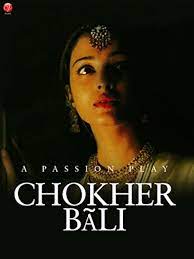 In terms of the depth delineated within the decorative, feudal milieu, Chokher Bali ranks as high, if not higher than Satyajit Ray’s adaptation of Tagore in Ghaire Bhaire. The same eye for (early 19th century) period details with incidental sounds, including nationalist chants, seeping into the soundtrack to create a climate of passionate foreboding…. Abhik Mukherjee’s cinematography manages to be opulent without getting ornate. The camera looks into its characters outer and inner lives with equal measures of style and spontaneity.
In terms of the depth delineated within the decorative, feudal milieu, Chokher Bali ranks as high, if not higher than Satyajit Ray’s adaptation of Tagore in Ghaire Bhaire. The same eye for (early 19th century) period details with incidental sounds, including nationalist chants, seeping into the soundtrack to create a climate of passionate foreboding…. Abhik Mukherjee’s cinematography manages to be opulent without getting ornate. The camera looks into its characters outer and inner lives with equal measures of style and spontaneity.
Bioscopewala lodges itself into the recesses of our parched hearts. With its artless freewheeling audacious adaptation of Rabindranath Tagore’s deeply moving story, Kabuliwala, the film sets up a wistful picture-perfect world of regret and heartbreak. The fragility and yet the miraculous permanence of a relationship that grows between an Afghani migrant Rehmat Khan (Danny Denzongpa) and a little girl Mini (played by the wonder Miraya Suri) recalls Ashok Kumar and Sarika in Hrishikesh Mukherjee’s Ashirwad.
8. Kabuliwala(2023):
How many times have we watched Rabindranath Tagore’s timeless tear-jerking tale brought to the screen? Whether it was the mighty Chabi Biswas or later Balraj Sahni and the various avatars of the original dryfruit seller from Afghanistan who befriends a little girl in Kolkata, the inherent power of the story to move you to tears remains immovable. This version directed by Suman Ghosh (Kadambari, Basu Poribar) is reflective of a gradually changing society and also attentive to the basic innocence of the original story and the salient character. Mithunda in his career’s best performance, negotiates the tricky transitional hurdles of the character by stripping Rehmat of all artifice and vanity. Rehman’s innocence is played such a restrained pitch that cynical readings of his attachment to little Mini are swiftly thrown out of the window. Shot in the quaint bylanes of Kolkata, Kabuliwala acquires its strength from its central performance. Mithun’s body language, his eyes gleaming with joy when dancing with little Mini and brimming with unshed tears when his Mini fails to recognize him at the end, reminded me of Chabhi Biswas, Ashok Kumar (in Aashirwad) and Balraj Sahni. But finally though, Mithunda makes this Kabuliwala his own.
9. Darbaan (2020):
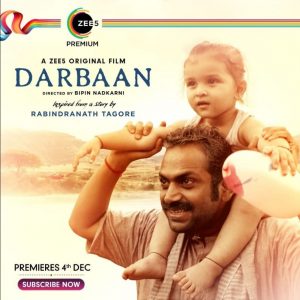 There is something about Rabindranath Tagore’s stories that lends itself to great cinema. Darbaan is not a great film. But it’s a very good piece of cinema. Artistically imagined and gently executed, it has the very accomplished Sharib Hashmi playing a simple caregiver in a feudal family (the story is translocated from the end of zamindari to the takeover of the coalmines in Dhanbad in the early 1970s) whose life is a litany of subservience.
There is something about Rabindranath Tagore’s stories that lends itself to great cinema. Darbaan is not a great film. But it’s a very good piece of cinema. Artistically imagined and gently executed, it has the very accomplished Sharib Hashmi playing a simple caregiver in a feudal family (the story is translocated from the end of zamindari to the takeover of the coalmines in Dhanbad in the early 1970s) whose life is a litany of subservience.
10. Charulata (1964):
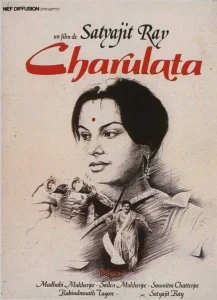 And finally, the finest Rabindranath Tagore screen adaptation of all times. With Satyajit Ray, it is always hard to imagine which was more memorable: the character or the actor playing the character. My favourite Ray-creation is Madhabi Mukherjee in Charulata. A beguiling complex exasperatingly paradoxical shout-out to womanhood, Charulata is unarguably Ray’s most fascinating character. She is at once Everywoman and yet fiercely individualistic.
And finally, the finest Rabindranath Tagore screen adaptation of all times. With Satyajit Ray, it is always hard to imagine which was more memorable: the character or the actor playing the character. My favourite Ray-creation is Madhabi Mukherjee in Charulata. A beguiling complex exasperatingly paradoxical shout-out to womanhood, Charulata is unarguably Ray’s most fascinating character. She is at once Everywoman and yet fiercely individualistic.

